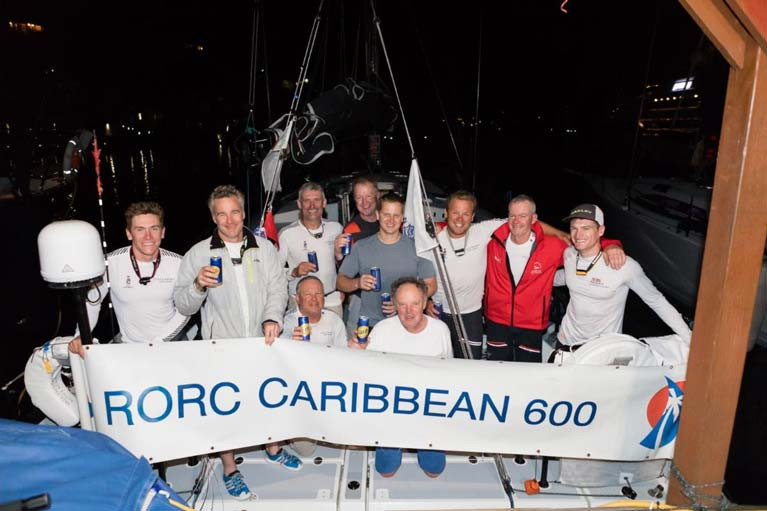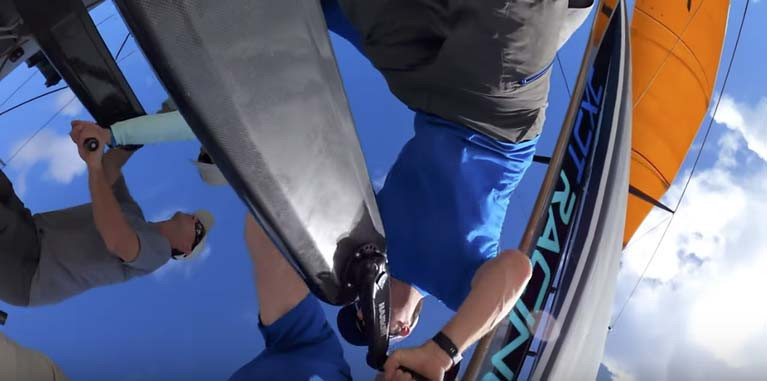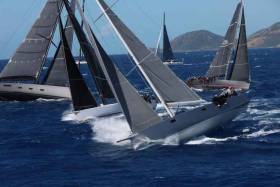Displaying items by tag: Caribbean 600
RORC Caribbean 600 Countdown
With nearly 80 entries racing under the IRC Rating Rule, MOCRA and Class40 division the RORC Caribbean 600 is set for its 13th edition.
The race has attracted over 600 sailors from 30 different nations and will start off Fort Charlotte, Antigua on Monday 21 February at 1100 AST (1500 GMT).
Undoubtedly a bucket-list offshore event, the racecourse rounds 11 Caribbean islands, testing the mettle of both crew and craft. The Royal Ocean Racing Club’s classic 600-miler delivers superb winter racing in the Caribbean, with fast angles, ocean swell and tropical temperatures.
“The RORC Caribbean 600 and Antigua is like coming home to family; we just love the event and people. After missing the 2021 event we are absolutely delighted to have so many amazing entries,” says RORC Caribbean 600 Race Director, Chris Stone.
“The competition is going to be intense and we hope this is good sign for our other events later in the year. Although we have so many great events like the Sevenstar Round Britain and Ireland and RORC Baltic Sea Race in 2022, there is a special place in our hearts for the RORC Caribbean 600. With sun, great trade winds and the Caribbean atmosphere, there is just something for all offshore sailors here,” continues Stone.
 Farr 100 Leopard
Farr 100 Leopard
Monohull Line Honours is likely to be decided by three Maxi Yachts: The Club Swan 125 Skorpios, Verdier/VPLP 100 Comanche, and the Farr 100 Leopard. IRC Super Zero has six versions of the Volvo Open 70 design, plus the 115ft Swan Shamanna, and the Mills 68 Prospector.
After a thrilling finish in the 2022 RORC Transatlantic Race, Maserati, PowerPlay and Argo will lock horns again for Multihull Line Honours. Eleven multihulls are currently entered for the race under the MOCRA Rule and a multitude of proven winners will be in the hunt for MOCRA glory after time correction.
Ten Class40s have answered the call and with explosive speed and close competition, it will be a wild ride for teams from France, USA and Italy. Unquestionably this is a tough race for Class40s; with little sleep or respite for crews due to the multitude of sail changes and harsh conditions.
The overall winner for the RORC Caribbean 600 Trophy is decided by IRC time correction. While the Line Honours contenders will be in the hunt for the double, teams racing in IRC Zero and IRC One have an equal chance of winning the race after time correction.
The RORC Caribbean 600 has a huge variety of wind speed and direction, ever changing by the effects of rounding islands. The overall winner is likely to be the boat that enjoys favourable conditions, raced by a team that produces the best performance - a true sporting challenge.
Boyd, King & Murphy are IRC One Winners of RORC Caribbean 600
The Royal Irish Yacht Club's Michael Boyd, 1996 Greystones Olympian Marshall King and James Murphy have won IRC One of the RORC Caribbean class sailing onboard Giles Redpath's Pata Negra.
In the early hours of the fifth day of the RORC Caribbean 600, a fantastic battle came to a dramatic conclusion. In the 18-strong IRC One feet, after time correction and on the water, two yachts rose above the rest to fight for the class win, but a final twist was still to come.
Redpath's Lombard 46 Pata Negra (GBR) and Philippe Frantz's NMD43 Albator (FRA) had been locked in a duel for 400 miles. Pata Negra, with a lower IRC rating had held the advantage for much of the race. However, having rounded Guadeloupe, Albator pulled ahead on the reach to Barbuda. The extra turn of speed put the French team just seconds ahead of Pata Negra after time correction. The last leg, a gruelling 35nm beat to the finish looked to be decisive. Like two boxers going into the final round, they gave their all, with Albator seemingly taking the win by a narrow margin. However, Pata Negra protested Albator for unintentionally entering an exclusion zone at Terre de Bas, resulting in Albator placing third and Pata Negra provisionally winning the class. Pata Negra and Albator remain friends, sharing breakfast together after the ruling.
Just hours before finishing the race, provisionally taking second place in IRC Two, Pamala Baldwin contacted the media team from her J/122 Liquid, which is skippered by Jules White with a young team looking to make sailing a career, as well as their passion. "We did the best that we could do and that gives me such a warm feeling to race with such a great team. I am touched by how we race and how much effort we put in. We are going to party tonight," exclaimed Pamala Baldwin.
In IRC Three, Peter McWhinnie's JPK 10.80 In Theory (USA) is the first boat to cross the line and having provisionally won IRC 3. At 1100 local time (1500 GMT), 29 boats are still racing in the RORC Caribbean 600. With the prize giving tonight, the RORC Race Team are hoping that all of the teams will return to Antigua before the big celebration at the Antigua Yacht Club. A full report will follow the prize giving.
Irish Sailors Vying for RORC Caribbean 600 Victory in IRC One & Two
Ireland is very much in the mix at the top of the IRC divisions as the RORC Caribbean 600 enters its final stages. At 1000 (1400 GMT) on Thursday 27th February, 52 yachts are still racing under IRC for the overall win for the RORC Caribbean 600 Trophy. Outsider is leading IRC overall and IRC Zero but a fierce battle is raging in IRC One between two equally matched yachts. Giles Redpath's Lombard 46 Pata Negra (GBR) with three Irish sailors on board and Philippe Frantz's NMD 43 Albator (FRA) are approaching the Barbuda mark for the second time, with just over 100 miles to go.
Approximately 180 miles from the finish, the competition is also fierce in IRC Two. Ross Applebey's Oyster 48 Scarlet Oyster (GBR) is estimated to be leading by 43 minutes on corrected time from Global Yacht Racing's First 47.7 EH01 (GBR), skippered by Andy Middleton and with Laura Dillon of Howth crewing. Pamala Baldwin's J/122 Liquid (ANT) is estimated to be just an hour off the lead after time correction.
In IRC Three, Peter McWhinnie's Larchmont YC team racing JPK 10.80 In Theory (USA) is leading the class on the water and estimated to have a solid lead after IRC correction. In the Class40 Division, 115nm from the finish, BHB sailed by Arthur Hubert is dead-level with Morgane Ursault Poupon's UP Sailing.
For the second year in a row, David and Peter Askew's Volvo 70 Wizard (USA) has taken Monohull Line Honours in the RORC Caribbean 600. Adrian Keller's Nigel Irens-designed catamaran Allegra (SUI) is the provisional winner of the MOCRA Class. Tilmar Hansen's German TP52 Outsider has finished the race and is currently the overall leader under IRC for the RORC Caribbean 600 Trophy.
Last year's overall winner Wizard struggled in the light air for the first part of the race, but lit up having rounded St.Maarten, blast reaching 140nm to Guadeloupe in just 11 hours. Having negotiated the wind shadow behind Guadeloupe, Wizard pulled the trigger, blast reaching in the Atlantic, smoking through the 90nm to Barbuda in just five hours.
"Driving in light airs is pretty sticky," commented Peter Askew. "We had just had a couple of times where we were at triple zeros, but other than that it was just keeping the boat going the best you could. Wizard is not the best light airs boat, that's for sure. We had to dig ourselves out of a hole. We finally got around Outsider (TP52) at Monserrat and Prospector (Mini Maxi) at Guadeloupe. We got into really good breeze up to Barbuda, just blast reaching, doing 22-24 knots the whole way."
Adrian Keller's Nigel Irens-designed catamaran Allegra is the provisional winner of the multihull class after MOCRA correction. Allegra has been extended to 83ft with two aft water ballast tanks providing up to 800kg of righting moment. Weighing in at 30 tons, with a full interior, Allegra is the heaviest multihull taking part in this year's race.
"We didn't make it to the finish line in the last two long races, so we are very happy and it will be all the sweeter if we win MOCRA," commented Adrian Keller. "As the heaviest boat we don't like light air, but a special sail we call a J0 allows us to go pretty tight to the wind. As soon as we get into 15 knots and more we are really fast, and it was tremendous fun. One of the deciding parts of this race was how long you were parked up. We did a good job at most of the islands, but like everyone else, we stopped in the lee of Guadeloupe. However, when you get around the corner and that trade wind hits you, it's full on."
Tilmar Hansen was a happy man this morning as dawn broke on his 70th birthday. Hansen's TP52 Outsider (GER), skippered by Bo Teichmann, crossed the finish line just after 7 a.m. local time to post the best corrected time so far under IRC.
"We have done a lot of water-proofing since the Rolex Fastnet, and there was definitely more water outside than inside!" smiled Tilmar Hansen. "This race has sunshine, hospitality, and great people. To celebrate my birthday here today, nothing could be better."
Irish Sailors Leading in IRC 1 & 2 of RORC Caribbean 600 Race
Irish sailors are topping the leaderboard in divisions IRC One and IRC Two by dusk on the second day of the RORC Caribbean 600 race.
In IRC One, Giles Redpath's Lombard 46 Pata Negra continues at the top of the rankings with three Irish crew Michael Boyd of the Royal Irish Yacht Club, Marshall King of the Royal St. George Yacht Club and James Murphy. Global Yacht Racing's First 47.7 EH01, skippered by Andy Middleton and with Howth Yacht Club's Laura Dillon as part of the crew is estimated to be the leader of IRC Two after IRC correction. Ten Irish sailors are competing in the race.
The entire monohull fleet in the race was at the northernmost extremity of the course negotiating the chicane of islands; Saba, St. Barths, and St. Maarten. Tilmar Hansen's TP52 Outsider (GER) is estimated to be leading IRC Zero and the race overall for the RORC Caribbean Trophy. Eric de Turckheim's NMD54 Teasing Machine (FRA) is estimated to be second. In third is one of the smallest boats in the race, Yoyo Gerssen's Ohlson 35 Cabbyl Vane (NED).
In IRC Two Handed, Richard Palmer's JPK 10.10 Jangada (GBR), racing with Jeremy Waitt, has the top position. In the Class40 Division BHB, sailed by Arthur Hubert (FRA), has a 15-mile lead.
Rankings and boat positions are available on the YB Tracker page: http://yb.tl/C6002020#
Boyd, King & Murphy on 'Pata Negra' Are Vying for RORC Caribbean 600 Lead
Michael Boyd is chasing the overall lead on board Giles Redpath’s Lombard 46 Pata Negra after the first 100 miles sailed in the 12th edition of the RORC Caribbean 600, organised by the Royal Ocean Racing Club in Antigua.
The proven Pata Negra lies second in IRC One and third overall on IRC in a gentle start to the race yesterday.
Three Irish sailors are on Pata Negra, some of ten Irish competing in this week's race. As well as former RORC Commodore Boyd, 1996 Olympian Marshall King (and more recently a J70 champion) and James Murphy are all onboard.
It is the fourth Caribbean 600 race for the Round Britain and Ireland winner. Redpath is joined by an experienced group of inshore and offshore sailors - a mix of professionals and good friends who all have all sailed with him on Pata Negra.
The Lombard 46 was third in class in 2019 and second in ’the 18 race under Michael Wright of Howth Yacht Club. Andy Lis is boat captain and he will be backed up by Will Harris as navigator, Sam Matson on trim and Royal Irish's Boyd on the helm.
Race Start
The impressive 73-boat fleet gathered outside Antigua's English Harbour, relishing the prospect of racing 600nm in stunning conditions. A light south-easterly breeze gave a gentle start to the race, but the fierce competition was exemplified by highly competitive starts right through the fleet. Lighter than usual conditions are forecast for the first 24-hours of the race, adding another level of strategy to the fascinating race around 11 Caribbean islands.
First to go was the combined IRC Three and IRC Two fleet of 26 boats. The second start was for IRC One and the Class40 division, featuring 23 teams. The IRC Zero start featuring 17 of the fastest monohulls in the race was highly aggressive. The Multihull start featured eight teams.
Tracker here
Antigua Buzzing as RORC Caribbean 600 Race Sets Sails (Preview Video)
The 12th edition of the RORC Caribbean 600 starts this morning at 1100 local time (1500 GMT), Antigua. The diverse fleet - that includes ten Irish sailors - will be competing in four classes, with 74 entries sailed by over 700 crew members representing 37 nations.
Antigua has been buzzing with sailors preparing for the 600nm race around 11 islands. The diversity of competing yachts is matched by the variety of sailors taking part.
The sport of sailing is like no other - world-famous sailors compete with and against passionate corinthian sailors. On the docks in Antigua, this eclectic mix share their thoughts prior to the start of the spectacular race in this vid below.
RORC Caribbean 600 Countdown Is On
With less than two weeks until the start of the 12th edition of the RORC Caribbean 600, boats and crew are beginning to arrive in Antigua. The marinas in Falmouth and English Harbour are starting to buzz with activity as sailors from all over the world come to prepare their yachts for the 600-mile race around 11 Caribbean islands. Around 70 teams will be taking part with well over 700 sailors competing.
As Afloat previously reported, there will be strong Irish interest in the race with up to ten Irish sailors competing.
Giles Redpath's Lombard 46 Pata Negra (GBR) sailed to Antigua after the 2019 RORC Transatlantic Race. Boat Captain Andy Lis has been busy preparing the boat for the team's arrival. Amongst Redpath's crew for the race will be past RORC Commodore Michael Boyd of the Royal Irish Yacht Club in Dun Laoghaire, Figarists Sam Matson and Will Harris, and the current J/70 Corinthian World Champion helm, Marshall King who originally hails from Greystones Sailing Club in County Wicklow.
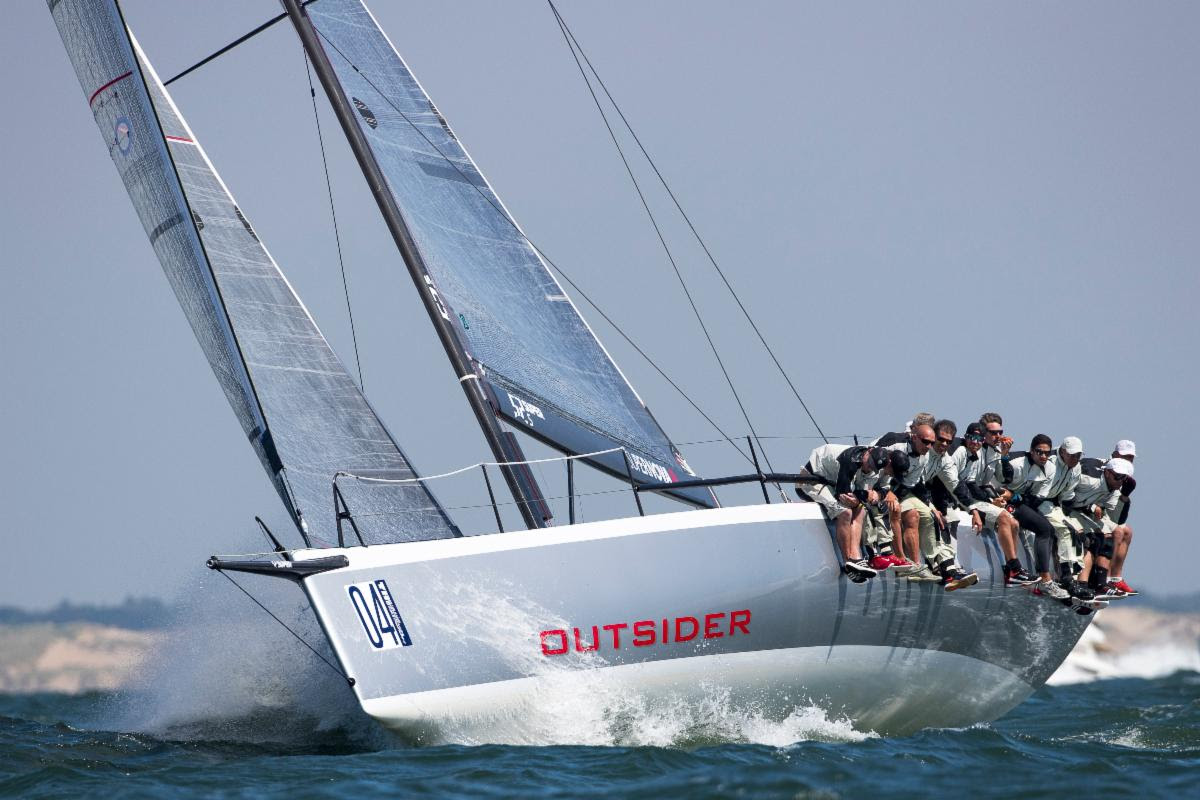 In Antigua and preparing for the RORC Caribbean 600 - Tilmar Hansen's German TP52 Outsider Photo Sander van der Borch
In Antigua and preparing for the RORC Caribbean 600 - Tilmar Hansen's German TP52 Outsider Photo Sander van der Borch
One of the largest yachts on the entry list, Jeroen Van Dooren's Swan 95 Lot99 (NED), has arrived in Antigua. "6076nm from Cape Town to Antigua, filled with sunshine, plenty of rain, flying fish and lots of biscuits! Happy to be back on island time," commented crew member, Penny Chapman. "We sailed from Cape Town to St. Helena, stopping only for supplies, then crossed the Atlantic to Fernando de Noronha, off Brazil. The crew saw an amazing display of spinner dolphins before we set off north. We were blessed with fast-reaching conditions up to Antigua - Lot99 was in her element," continued Lot99 Boat Captain, Dan Newman.
Three Cookson 50s will be competing in this year's race, but they are far from identical. Zoe Taylor and Chris Way will be racing Grace O'Malley (AUS), named after the 16th-century pirate queen of Ireland. Zoe Taylor hails from Australia and has competed in three editions of the Rolex Sydney Hobart. Grace O'Malley was formerly called Lee Overlay Partners; overall winner of the 2009 RORC Caribbean 600. Ron O'Hanley's Privateer (USA) has the tallest rig of the three and an extended bowsprit. Privateer won the race overall in 2013 and was second in 2018.
Joseph Mele's Triple Lindy (USA) also has an extended bowsprit and now has a fixed keel which can extend to 3.8 meters. "We just have to get the right conditions to suit our set up," explained Brad Kellett, Boat Captain for Triple Lindy. "We don't have the same form-stability as the two canting keelboats, but we do have the lowest rating under IRC. If we can perform to our rating, we should do well."
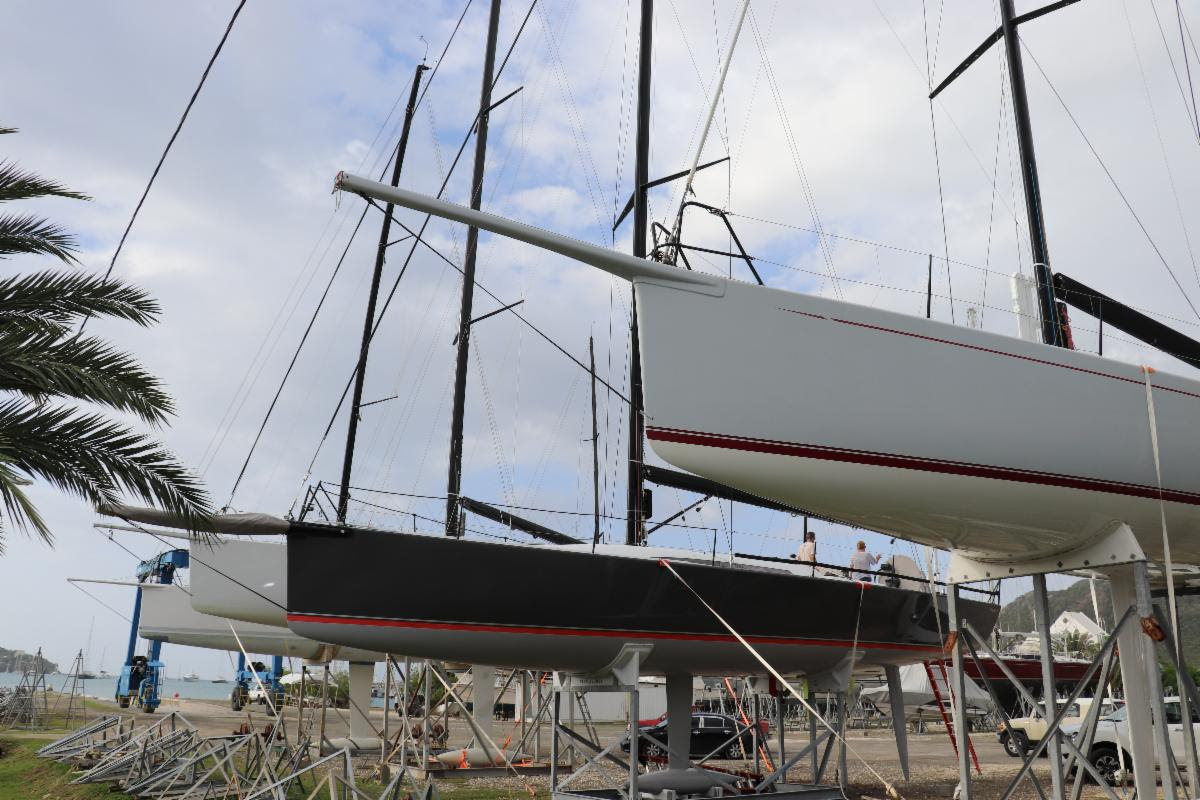 Three Cookson 50s will be battling it out at this year's RORC Caribbean 600 Photo Louay Habib
Three Cookson 50s will be battling it out at this year's RORC Caribbean 600 Photo Louay Habib
One of several hi-tech yachts in this year's race is Tilmar Hansen's TP52 Outsider (GER). The Judel/Vrolik design as Platoon won the 2017 Rolex TP52 World Championship, and as Outsider was fourth overall in the 2019 Rolex Fastnet Race. Australian Lindsay Stead has recently joined the team and is in Antigua helping prepare Outsider for the race. "After the Fastnet, it was decided to work on the bunks below and also to improve waterproofing in general," commented Stead. "Outsider will have 15 crew for the race, as that is what she was designed for in terms of righting moment. We have two manual pedestal grinders, and especially for the long reach down to Guadeloupe, we will be swapping out the crew. We are prepared for a wet ride, and in terms of ideal wind conditions, if the breeze sits at around 16 knots, that will be ideal for Outsider."
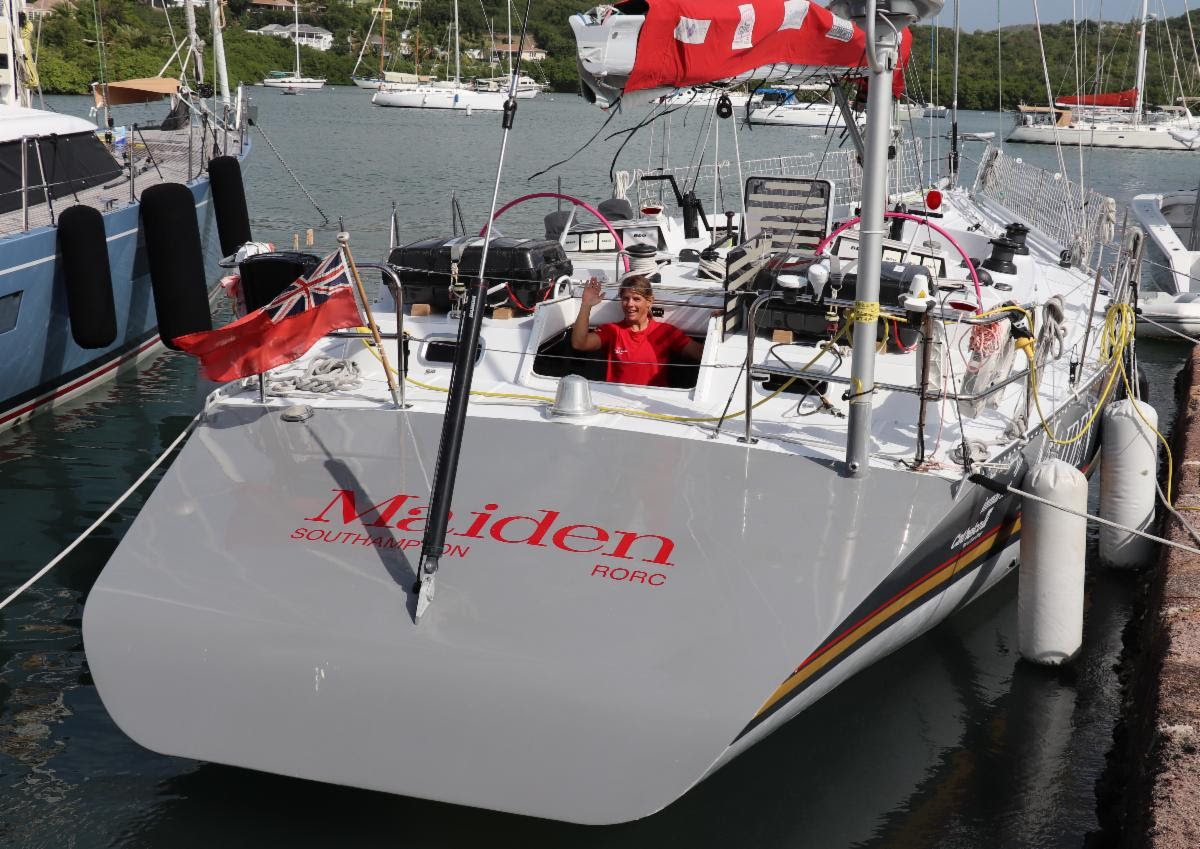 Liz Wardley will skipper Tracey Edwards' Farr 58 Maiden which will be racing for the first time since the '89-'90 Whitbread Round the World Race Photo: Louay Habib
Liz Wardley will skipper Tracey Edwards' Farr 58 Maiden which will be racing for the first time since the '89-'90 Whitbread Round the World Race Photo: Louay Habib
The Farr 58 Maiden (GBR), skippered by Tracy Edwards, was runner-up in the 1989-90 Whitbread Round the World Race. Maiden has been beautifully restored and will be captained by Liz Wardley, who has competed in three editions of the Volvo Ocean Race. For the RORC Caribbean 600, Maiden will have race crew and also guests who are making donations to the Maiden Factor Foundation, which seeks to advance the education of girls up to 18 years old, all over the world. The film Maiden (2019) was shortlisted for the Oscars this year and will get a special screening in Antigua before the race.
"Tracy wanted to keep Maiden as original as possible," commented Wardley. "The deck layout is much as it was in 1989, but the equipment is modern. The rig is a little shorter, but we will be running symmetrical spinnakers as Maiden did over 30 years ago. I got a nice surprise when we arrived in Antigua when we tied up very close to a competitor, Esprit de Corps III. The boat was originally Amer Sports One in the 2001-02 Volvo Ocean Race, and I was crew on the sistership Amer Sports Too!"
Dimitry Kondratyev will skipper yuri Fadeev's First 40 Optimus Prime (RUS). The all-Russian team have been competing at Grenada Sailing Week before sailing to Antigua. "The crew come from all over Russia; Moscow, St. Petersburg, and Siberia," commented Kondratyev. "It is great to be back in Antigua, and we are all looking forward to the race. We have only eight on board, which is a bit light, especially if it is as windy as last year."
The 2020 RORC Caribbean 600 is scheduled to start on 24th February 1100 local time (1500 UTC).
Ten Irish Sailors to Contest RORC Caribbean 600 Race
So far ten or more Irish sailors have registered as crew members on the following boats for the Royal Ocean Racing Club's Caribbean 600 Race starting in less than a month.
The inaugural 2009 winner, Royal St. George's Adrian Lee with Lee Overlay and Partners returns this time on a Swan 60 as Afloat previously reported here.
 Adrian Lee of the Royal St. George Yacht Club
Adrian Lee of the Royal St. George Yacht Club
Starting on Monday, 24 February, teams from around the world will descend on Antigua for the non-stop race around 11 islands.
Three Irish sailors are on Pata Negra, Giles Redpath’s Lombard 46 that competes in IRC One. Former RORC Commodore Michael Boyd, 1996 Olympian Marshall King (and more recently a J70 champion) and James Murphy are all onboard. It is the fourth Caribbean 600 race for the Round Britain and Ireland winner. Redpath is joined by an experienced group of inshore and offshore sailors - a mix of professionals and good friends who all have all sailed with him on Pata Negra.
 Michael Boyd of the Royal Irish Yacht Club
Michael Boyd of the Royal Irish Yacht Club
The Lombard 46 was third in class in 2019 and second in ’the 18 race under Michael Wright of Howth Yacht Club. Andy Lis is boat captain and he will be backed up by Will Harris as navigator, Sam Matson on trim and Royal Irish's Boyd on the helm.
In his 90th year, American Don Street, who hails from Glandore in West Cork, will compete on Kinship.
The lifetime sailor has spent 45 years cruising, charting and writing about the Caribbean for his famous guide books. 40 of those years were spent in his 46ft engineless yawl, Iolaire, built-in 1905.
Iolaire flew the RORC burgee for 80 years!
“My nickname used to be ‘squeaky’ but with the way I am having holes cut in me, it should be changed to ‘swiss cheese’, says Street. He will be racing with a team who has sailed and raced Kinship for over a dozen years, with good results in ocean races and local regattas along the East Coast of the US. Oldest combined crew ages? A 91-year-old will also on be on board!
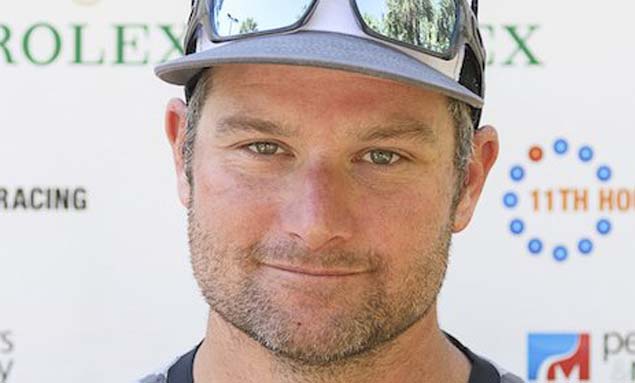 Ronan Grealish of Galway Bay Sailing Club
Ronan Grealish of Galway Bay Sailing Club
Elsewhere in the fleet, Galway Bay's Ronan Grealish competes on the Swedish VO65 Childhood 1.
Helen Flannery competes on the French-flagged Aminata.
Howth Yacht Club's Laura Dillon is on the British Beneteau 47.7 EH01.
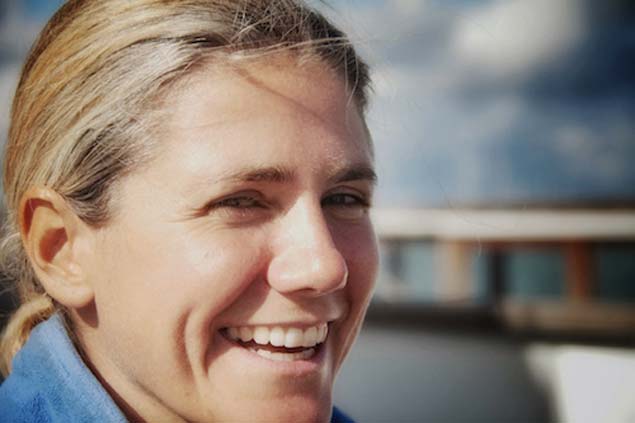 Howth Yacht Club's Laura Dillon
Howth Yacht Club's Laura Dillon
Neil Maher is on the Sail Racing Academy Beneteau 40.7 Escapado and Clipper Round the World Skipper Sean McCarter is on the 25m Swan, Umiko. This is the same vessel that took a National Yacht Club crew across the Atlantic on the ARC before Christmas 2019 as Afloat reported here.
For many, it will be their first time in the race, whilst for others, it's a chance to defend their titles or improve on past results as they are lured back to this challenging race.
2020 RORC Caribbean 600 Battle Lines are Forming
The 12th edition of the Royal Ocean Racing Club's Caribbean 600 will start on Monday 24th February 2020 from Antigua. Already the early entries are nudging towards an eclectic mix of 50 boats, with competition expected to be as red hot as ever. Previous overall and class winners are already committed to the thrilling 600-mile race around 11 Caribbean islands.
"A key ingredient to a great event is a good mix in the fleet and the early entries are showing that we will have fierce and friendly competition in every class," commented RORC Racing Manager Chris Stone. "As well as the race for overall and class honours, there are battles within the fleet between boats of similar speed. Close competition is a great catalyst for performance and the RORC is really excited about the prospect of another thrilling edition of the RORC Caribbean 600."
Last year's overall winner, American Volvo 70 Wizard will have a stellar crew led by David and Peter Askew. Wizard will be attempting to retain the RORC Caribbean 600 Trophy, a feat never achieved in the 11 previous editions of the race. Winning IRC Zero will be Wizard's first goal and to do so, they will need to beat 2013 overall winner, Ron O'Hanley's American Cookson 50 Privateer, which was runner-up to Wizard last year. IRC Zero will also include Joe Mele's American Cookson 50 Triple Lindy. A trio of canting keel round the world racing yachts; VO65 Childhood 1, VO70 I Love Poland and Volvo 70 Telefonica Black will also compete in the class.
Entered for the RORC Caribbean 600, but still awaiting class clarification, is one of the most famous round the world racing yachts, Farr 58 Maiden, which made history in 1989 as the first all-female crew to sail around the world in the Whitbread Round the World Yacht Race, coming second overall. The largest yacht entered to date is the Swan 95 Lot99 sailed by Jeroen Van Dooren.
Entries in IRC One include the 2018 class winner Philippe Frantz with his NMD 43 Albator. Giles Redpath's British Lombard 46 Pata Negra is also entered and was third in class last year, and second in 2018. Bernie Evan Wong's RP37 Taz, class winner in 2017, will be proudly flying the Antiguan flag. Bernie has skippered a yacht in all previous 11 editions. Kevin McLaughlin's American Xp55 Rye will see the father and son team return. Their best result was third in class with Spice in 2018. Adrian Lee was the overall winner in the first RORC Caribbean 600 in 2009 and this year will be racing his Swan 60 Lee Overlay Partners.
Ross Applebey's British Oyster 48 Scarlet Oyster is probably the most successful yacht in the history of the race. Racing Scarlet Oyster, Applebey has led his team to class victory on five occasions, and Ross also won on Scarlet Island Girl in 2017 to keep a winning streak dating back to 2012. Competition in IRC Two will be as hot as anywhere, with the entire class podium from 2019 entered, including last year's runner up, Global Yacht Racing's British 47.7 EH01, skippered by Andy Middleton, and Pamala Baldwin's Antigua J/122 Liquid.
IRC Three will have some of the smallest yachts racing in the RORC Caribbean 600, and arguably the toughest race in terms of stamina and tenacity to complete the 600-mile course. Richard Palmer's British JPK 10.10 Jangada, overall winner of the 2019 RORC Transatlantic Race, will be racing Two Handed with Jeremy Waitt. For another victory, Jangada will have to out-perform larger fully crewed yachts.
Three of the world's fastest multihulls will also be on the startline; Jason Carroll with Argo (MOD 70), Giovanni Soldini's Maserati (Multi 70), and Peter Cunningham's PowerPlay (MOD 70) will be match racing for Multihull Line Honours, but the Multihull Class is decided by the MOCRA rating rule and last year's runner-up, Greg Slyngstad's American Bieker 53 Fujin will be back to try to better this result. Returning to the racecourse under new ownership is the Nigel Irens 63ft trimaran Shockwave. Formerly Paradox, which won the MOCRA Class in 2018, Shockwave will be sailed by multihull specialists Scott Klodowski and Jeff Mearing.
Caribbean 600’s Wild Wet Ride Brings Howth Yacht Club Glorious Reality of Top Offshore Racing
With winter still clinging like a hyper-cold limpet in northern latitudes, the prospect of balmy breezes and warm seas in the tenth annual RORC Caribbean 600 in late February seemed like the perfect prospect for escape and sport writes W M Nixon. After all, Irish sailors look on it with a certain proprietorial pride, with Adrian Lee’s Cookson 50 Lee Overlay Partners (Royal St George YC) winning the inaugural race overall in 2009.
Sea, sun, scenery and sailing – you have all that guaranteed for starters, even if only to enjoy it vicariously in following the event on many information streams. But then, as the start time approached at 11am local time Antigua on Monday 19th February, the growing entry list indicated an increasingly high quality lineup, with many powerful big boats and a swathe of professional crew.
Yet even if names of legendary fame and achievement were going to be competing, these was still a place for club entries with the necessary amateur experience to send forth crews, either on members’ own boats, or on judiciously-selected charter boats.
The “judicious selection” came in finding boats suitable for a rather specialised cat’s cradle of a course which can include a lot of power reaching, and takes in 11 island in order to have topped the 600-mile mark when the fleet finally returns to the finish line off the southern headlands of Antigua.
 The RORC Caribbean 600 – the start and finish is at the south end of Antigua
The RORC Caribbean 600 – the start and finish is at the south end of Antigua
With every sign that this year’s staging of the race would experience the northeast tradewinds in stonking form, we were encouraged a week ago to predict that George David’s mighty Rambler 88 might repeat her dramatic showing of line honours and a new mono-hull record, just as she did in the Volvo Round Ireland race of 2016.
Well, Rambler 88 did that, and she did it well, knocking more than two hours off the record her predecessor Rambler 100 set in 2011. But then as the rest of the fleet battled the course, it became increasingly likely that the big silver bullet could repeat her astonishing Irish success of the treble – line honours, course record (one day 13 hours and 41 minutes in the case of the Caribbean 600), and IRC overall win.
Several of Rambler 88’s challengers seemed within an ace of it, but the final 35 miles beat from Redonda back to the race’s focal point at the south end of Antigua saw them fail one after another to make the target, until by Wednesday only American Ron O’Hanley’s keenly-campaigned Cookson 50 Privateer – with Kinsale’s Ben Fusco as mastman - was in with a realistic chance, but that also faded on the final windward slugfest.
 Trebles all round! Rambler 88 on her way to matching her Round Ireland triple success
Trebles all round! Rambler 88 on her way to matching her Round Ireland triple success
It means that overall the Americans have dominated the podium for the top results even if Kinsale has a share of it, with Rambler a clear first, Privateer second, and the Volvo 70 Warrior (Steve & Stephen Murray Snr & Jnr) third. So why then is there a considerable element of RORC Caribbean 600 celebration this weekend on a certain peninsula on Ireland’s East Coast?
Well, the slightest delving into the more detailed class results shows that between them, the National YC in Dun Laoghaire, and Howth Yacht Club on the eastern peninsula, can come up with 1,2,3 in class places, and in an event of the calibre of the RORC Caribbean 600, those are placings which are very special indeed.
The third place (it was in Class 1) came from Irish-American Kevin McLaughlin’s J/44 Spice, skippered by his son Sean with former Irish college sailing stars Will Byrne and Chris Raymond of the National YC in a key role in the crew.
As for the second place, it was also in Class 1 and went to the interesting Marc Lombard designed IRC 46 Pata Negra, chartered by Michael Wright of Howth under the guidance of Kieran Jameson, and crewed by an almost entirely Howth YC team.
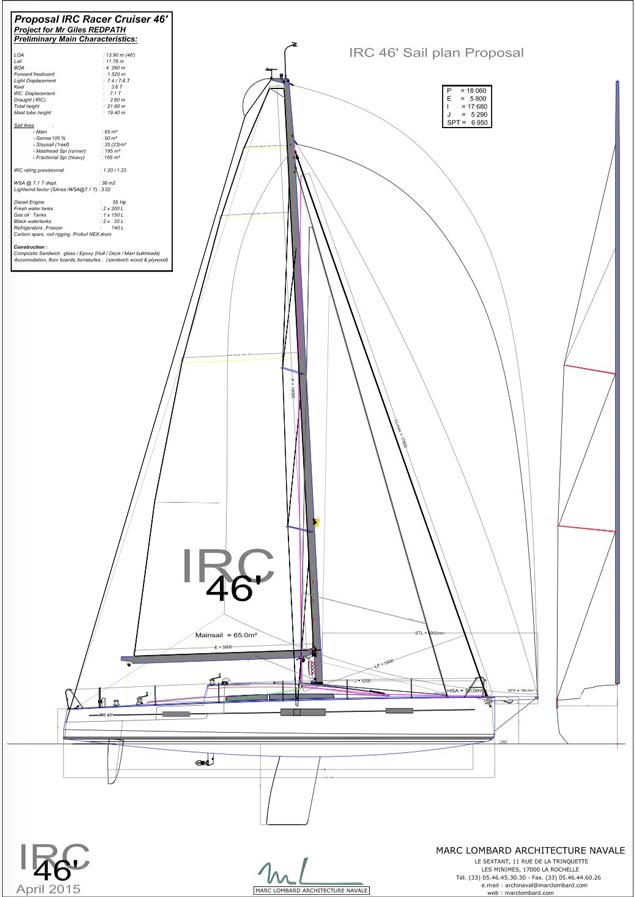 Marc Lombard’s interesting and stylish design for Pata Negra. There wasn’t a spinnaker left intact when she finished, but she still took a good second in Class 1
Marc Lombard’s interesting and stylish design for Pata Negra. There wasn’t a spinnaker left intact when she finished, but she still took a good second in Class 1
And the first place was a peach. It was in Class 3, and went to Conor Fogerty’s Sunfast 36 Bam! HYC, which filled the same position in the 2016 race, but has since been away on other business such as winning the east-west Single-Handed Transatlantic Race of 2017. Yet although she was the second-smallest boat in the race, the potent Bam! was by no means the lowest-rated, so she had to work for her placing in conditions which tested everyone.
For it has been something of a Demolition Derby. Of 74 monohull starters, only 40 finished. And while the ten multi-hulls recorded a better finish rate, one of their exits was the most dramatic of all – a capsize by the catamaran Fujin, fortunately without any serious outcome other than one inverted multi-hull, with her crew safely on top, near the island of Saba.
 She looks better right way up – the catamaran Fujin exited the RORC Caribbbean 600 in spectacular capsize style
She looks better right way up – the catamaran Fujin exited the RORC Caribbbean 600 in spectacular capsize style
While the possibility of such things was always present, the traditional pre-race festivities were special for the Howth contingent, as their own ex-Pat superstar Gordon Maguire arrived in from Australia to race aboard George Sakellaris’s much-fancied Maxi 72 Proteus. That the pre-race betting on Proteus was well-founded seemed justified after the first nine hours, as she narrowly had the overall lead on corrected time coming into the turn at Saba. But then an equipment failure led to her rapid retirement, and that was one favourite down, and others to follow.
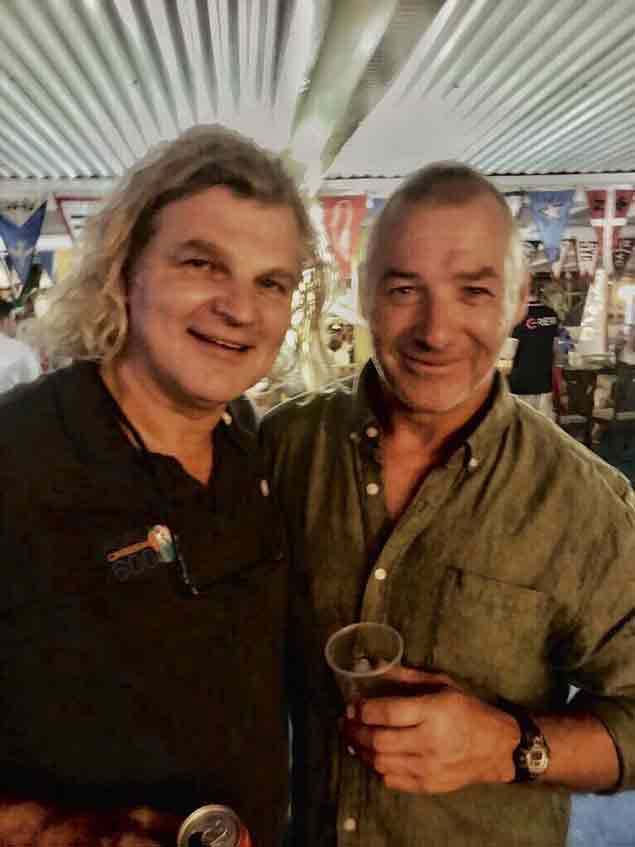 Local boys made good. Michael Wright and Gordon Maguire in Antigua before the start of the RORC Caribbean 600
Local boys made good. Michael Wright and Gordon Maguire in Antigua before the start of the RORC Caribbean 600
Last year’s overall winning navigator, Ian Moore, was aboard the German-owned Elliott 52 Outsider, a canting keel entry which certainly looked the part. But as an outsider bet she would have been a disastrous investment, as nothing seemed to be going right from the start, and she retired at the north end of the course.
By that stage, the retirals were coming thick and fast as sails and gear – and maybe crews too - failed the test. But the key Irish boats were hanging in, even if the crew on Pata Negra were going through spinnakers at such an alarming rate that by race’s end they didn’t have a single spinnaker left in the locker.
But the preponderance of miles of power reaching, and the presence of some beats which provided opportunities for sound tactical choices, enabled Pata Negra to offset her lack of downwind sails. In the two final beats – one along the much indented south coast of Guadeloupe, and the other from Redonda to the Antigua finish – it was a pleasure to watch how navigator Colm Birmingham was calling it spot on, reading the shifts to perfection and skillfully using any bit of lee in the shelter of headlands to enable Pata Negra to gain an extra fraction of speed and out-perform much larger boats around her.
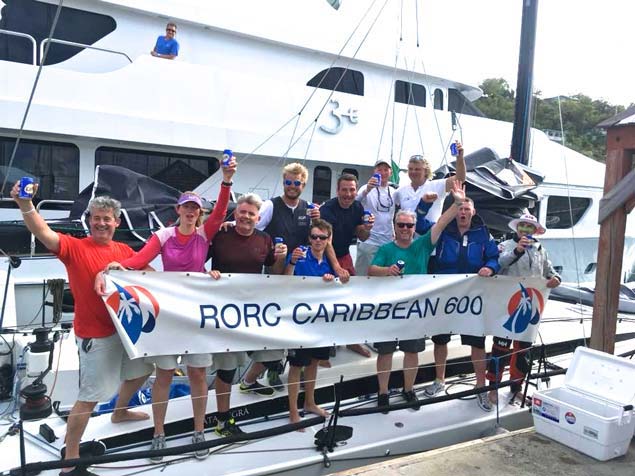 Pata Negra’s crew start the celebrations on their return to Antigua
Pata Negra’s crew start the celebrations on their return to Antigua
 Once upon a time, this was a sail – Kieran Jameson with a battle memento from Pata Negra
Once upon a time, this was a sail – Kieran Jameson with a battle memento from Pata Negra
Heaven only knows how many peninsula people were following the tracker on Thursday afternoon as Pata Negra got within ten miles of the finish, with the mid-day wind at Antigua really getting up a head of steam. And then, with 9 miles to go, her speed was shown as down at 4.3 knots, her heading straight towards the harbour…. Was she disabled and motoring?..... A great collective sigh of relief as the next position showed her back up towards 8 knots and better, fairly thrashing along to the finish and that second place, achieved despite the spinnaker eliminations.
It was all part of a choreographed and slightly emotional series of happenings put together by Brian Turvey, starting with a send-off party for the two crews in Howth YC. That had to be held on February 2nd as the Volvo/Irish Sailing/Afloat.ie “Sailor of the Month” and “Sailor of the Year” awards were to be held in the RDS the following weekend, Friday February 9th, and after that there was an HYC Achievers Celebration hosted by Commodore Joe McPeake on Saturday 10th February, following which it was Antigua all the way.
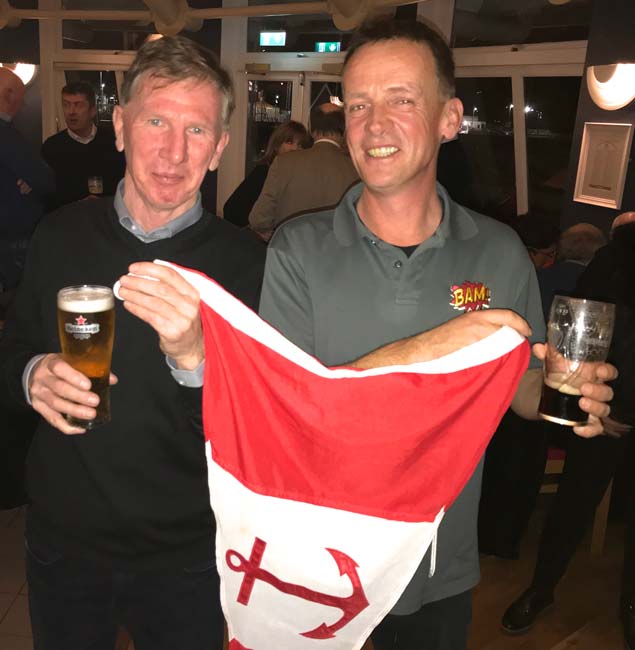 The choreography gets under way. Kieran Jameson and Conor Fogerty at the Caribbean 600 Goodwill Party in Howth YC on February 2nd. Within a week, Conor Fogerty was to become “Sailor of the Year 2017”, and within three weeks they’d recorded a second and first in class in the RORC Caribbean 600. Photo Brian Turvey
The choreography gets under way. Kieran Jameson and Conor Fogerty at the Caribbean 600 Goodwill Party in Howth YC on February 2nd. Within a week, Conor Fogerty was to become “Sailor of the Year 2017”, and within three weeks they’d recorded a second and first in class in the RORC Caribbean 600. Photo Brian Turvey
But by the time that Achievers Party came around, Conor Fogerty had become “Sailor of the Year” the night before, so he was doubly feted in his home club, and gave a moving little speech in which he frankly admitted that when he bought the boat new in 2015, he hadn’t a clue how to make her go well, but it was the encouragement of fellow Howth members which helped him up from being an also-ran to a winner.
Such thoughts were much in everyone’s mind through Thursday night as Bam! battled up that final beat to the finish, for another of the crews at that early-February party in Howth had been the combined National YC/Malahide YC team of Bernard McGranahan and Dermot Cronin, who were going to off to Antigua to race the J/122 Noisy Oyster, but they’d had to pull out with just 115 miles to sail, a really bad moment for Team Ireland.
But the Bam! supporters concerned about that final beat were heartened by some thoughts voiced in Conor Fogerty’s video from his OSTAR win:
“There you are, out in the ocean in the night in this light little boat in a gale, climbing up the side of a big sea that seems to go on up for ever in the darkness, and then you shoot out the top and become airborne for what seems a lifetime, and you’ve time to think that there’s no way this little plastic thing is going to survive hitting that very hard bit of water way down in the bottom of the trough, and then comes the crash which surely nothing can survive….but she does, she does survive without splitting open. And then she picks herself up, and just sails on, climbing the next mini-mountain that you know is right there in the dark”.
 Bam! and Liquid with a serious turning mark, the steep and deserted rock of Redonda. Photo RORC/Tim Wright
Bam! and Liquid with a serious turning mark, the steep and deserted rock of Redonda. Photo RORC/Tim Wright
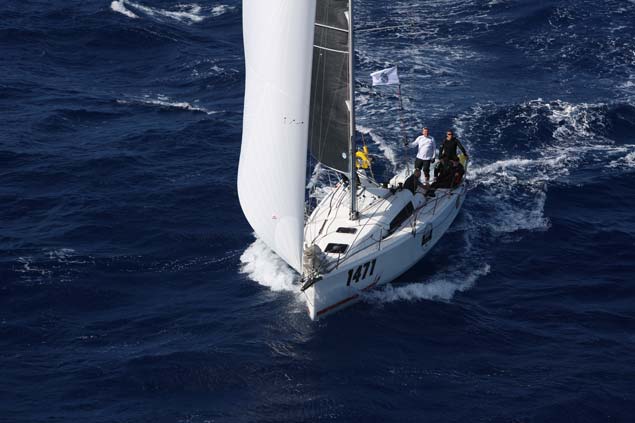 Nearly there. Bam! at Redonda, with just 35 miles to go – but it’s going to be a dead beat. Photo RORC/Tim Wright
Nearly there. Bam! at Redonda, with just 35 miles to go – but it’s going to be a dead beat. Photo RORC/Tim Wright
Set against that, the Redonda to Antigua beat was a walk in the park. But Bam! fans fretted until their boat was safely home around 4.30 am our time yesterday morning, and then it was time to relax and savour the moment. As for the Howth crews who have done the job and given their club such credit, aboard Pata Negra they were: Michael Wright, Kieran Jameson, Darren Wright, Colm Bermingham, Johnny White, Karena Knaggs, Sam O’Byrne, Ronan Galligan, Emmet Sheridan and Richard Cullen.
Aboard Bam!, in addition to skipper Conor Fogerty there was Simon Knowles and Anthony Doyle from the 2016 win, and the other three were Rob Slater, Robert Rendell and Damian Cody.
Here it is, still February, and they’ve had a season’s sailing and success already. It certainly blows away those winter blues.
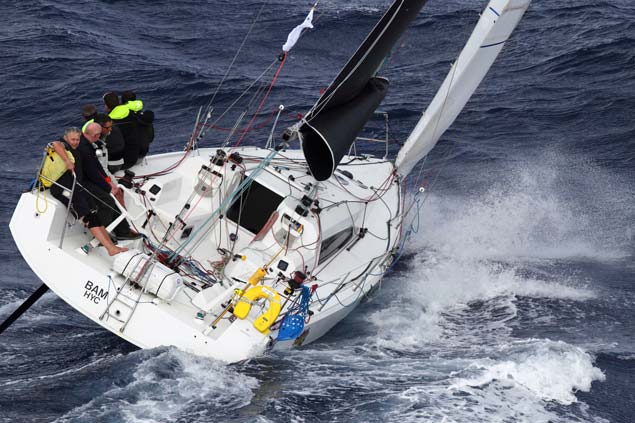 They’re absolutely knackered, but there’s still work to be done – the reefed Bam settles down for the final beat to Antigua. Photo: RORC/Tim Wrigh
They’re absolutely knackered, but there’s still work to be done – the reefed Bam settles down for the final beat to Antigua. Photo: RORC/Tim Wrigh
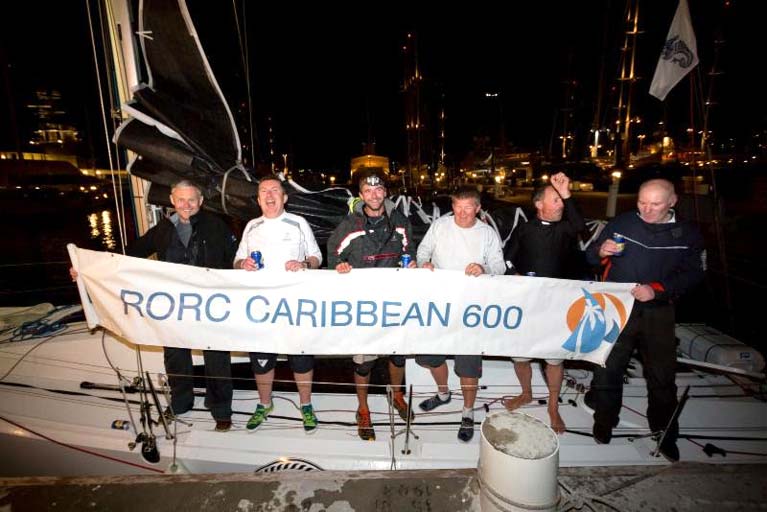 The Bam! crew roll out the banner dockside in Antigua....
The Bam! crew roll out the banner dockside in Antigua....




























